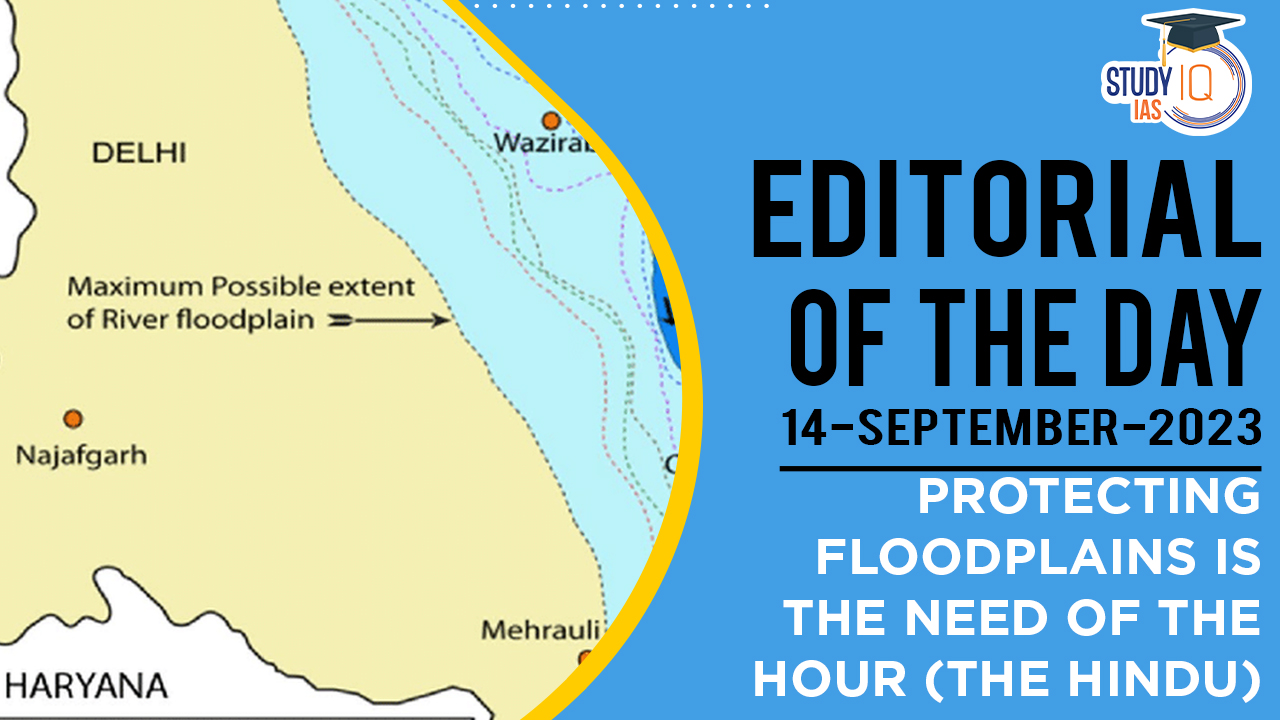Table of Contents
Context: The article is discussing the significant challenges India is facing due to both water shortages and excess water in the form of floods. It highlights how floods have been increasing in frequency and intensity, primarily due to climate change. It mentions several devastating flood events in different parts of India, such as Pakistan, Uttarakhand, Kashmir Valley, Chennai, Gujarat, and Himachal Pradesh, which have resulted in loss of lives, damage to infrastructure, and economic consequences. Overall, the article is addressing the urgent need to tackle the increasing frequency and severity of floods in India, the vulnerability of cities to flooding, and the shortcomings in the legal framework for flood risk management. It also talks about the environmental impact of illegal construction in flood-prone areas.
Background
What is Urban Flooding?
- Urban flooding refers to the inundation of land or built-up areas, particularly in densely populated locations such as cities, due to excessive rainfall that surpasses the capabilities of drainage systems to handle the water.
- Urban flooding is a major problem in many parts of the world, and it is the leading cause of global flood losses.
How urban flooding is different from rural flooding?
- Flood intensity: Urban flooding is significantly different from rural flooding as urbanization leads to developed catchments, which increases the flood peaks from 1.8 to 8 times and flood volumes by up to 6 times. Consequently, flooding occurs very quickly due to faster flow times.
- Vulnerability: As urban areas are densely populated; people are more vulnerable to flooding and secondary effect of exposure to infection.
- Economic impact: Urban areas being centers of economic activities have key infrastructure that has a bearing on national and global economy.
Urban Flood Risk in India
- There has been an increasing trend of urban flood disasters in India over the past several years whereby major cities in India have been severely affected.
- Recent events of urban floods include Chennai floods of 2015 Mumbai floods of 2017, Guwahati floods of 2010, Bengaluru floods 2017 and Hyderabad floods of 2020.
- There will be a rise in the frequency of floods in India due to rise in temperatures between 2070 and 2100, according to Climate Change and India: A 4×4 Assessment, a report by the Union Ministry of Environment and Forest.
- Regions susceptible to floods, according to the National Disaster Management Authority (NDMA), lie mostly along the Ganga-Brahmaputra River basin, from the northern states of Himachal Pradesh and Punjab, covering Uttar Pradesh and Bihar and stretching to Assam and Arunachal Pradesh in the northeast.
- The coastal states of Odisha and Andhra Pradesh, parts of Telangana and Gujarat also witness yearly floods.

Decoding the Editorial
- The article emphasizes that a considerable portion of India’s land area is prone to floods, and the problem is exacerbated in cities due to rapid and haphazard urbanisation.
- It points out that cities, in their expansion, often neglect natural topography, making them more vulnerable to disasters like floods.
- Given that Indian cities are expected to contribute significantly to the country’s GDP by 2030, the economic impact of flooding is a matter of concern.
- The article also raises a legal aspect, discussing how India primarily relies on the Disaster Management Act of 2005 to deal with disasters, including floods.
- However, it notes that this law is not specifically focused on flood risk management and does not adequately address the predictability of floods.
- Also, in India, there are significant issues with encroachments (illegal occupation) on floodplains. These encroachments contribute to more frequent floods and increased damage caused by flooding. For instance, it cites a report from 2018 by the Comptroller and Auditor General of India, which attributed the Chennai floods of 2015 to encroachments on the floodplains of rivers in Tamil Nadu, referring to this disaster as a “man-made disaster.”
Change in Strategy:
The article highlights a change in the approach to flood control and management in various countries, including Germany, the U.K., and the Netherlands, from a strategy of “flood protection” to one of “flood risk management.”
- Flood Protection Strategy:
-
- This refers to the traditional approach of mitigating the impact of floods by using technical measures like building dikes, temporary flood defence walls, and polders (low-lying land reclaimed from a body of water).
- These measures aim to physically block or divert flood waters to protect areas from flooding.
- Flood Risk Management Strategy:
- This represents a newer approach that focuses on not just protecting against floods but also managing the risks associated with them.
- The key elements of this strategy involve retaining water (allowing controlled flooding in certain areas) and restoring floodplains (the natural areas next to rivers that can absorb excess water during floods).
- This approach acknowledges that floods are a natural part of the environment and seeks to work with, rather than against, nature to reduce the impact of flooding.
Occupying Flood Plains:
- Illegal Construction in Floodplains: Construction work occurring in floodplain areas, where rivers naturally overflow during heavy rainfall or flooding events, is taking place without proper authorization or in violation of existing laws and regulations.
- Reduced River Capacity: Building in floodplains reduces the ability of rivers to contain large volumes of water during heavy rain, especially when water flows down from higher elevation catchment areas. This interference with the natural flow of water increases the likelihood of flooding.
- Neglect of Eco-Sensitive Floodplains: Uttarakhand, has allowed the construction of guest houses and hotels along riverfronts in floodplain areas. This has been done in an effort to promote tourism and stimulate economic growth but disregards the importance of preserving eco-sensitive floodplains.
- Attempts to Bypass Regulations: The National Green Tribunal had issued a directive in 2015, effectively prohibiting construction within 200 meters of the Ganga riverbanks to protect the environment. However, there have been attempts to circumvent these regulations, potentially through loopholes or non-compliance.
- Environmental Impact Assessments: There are concerns raised regarding whether environmental impact assessments, which are meant to evaluate the potential environmental consequences of construction and development projects, are being conducted properly in Uttarakhand.
- Ineffective Regulation: Despite the existence of laws and regulations at both the central and state levels aimed at protecting floodplains and the environment, these measures have not been effectively enforced. The article suggests that rampant mining and construction activities continue to occur with little consideration for environmental preservation.
- Climate Change Impact: The article acknowledges that while floods are a natural occurrence, their frequency and intensity are being exacerbated by climate change-induced rainfall. This is particularly concerning for mountainous regions like the Himalayas, where the impact of floods can be severe.
- Lack of State Implementation: Despite central policies and measures aimed at protecting floodplains, these are often not binding on individual states in India. As a result, floodplain encroachments persist in many parts of the country.
Preserving Ecosystem:
The article emphasizes the importance of preserving and protecting natural ecosystems, such as wetlands, forests, lakes, and coastal areas, as a strategy for reducing the physical impact of natural disasters like floods, landslides, or avalanches. It also discusses the need for legal and policy changes to address climate change adaptation comprehensively.
- Benefits of Ecosystem Preservation: Ecosystems, including wetlands, forests, and coastal areas, can act as natural buffers against natural hazards like floods and landslides. Preserving these ecosystems can help mitigate the impact of such disasters.
- Example from Germany: Germany’s change to its Federal Water Act in 1996 following a massive flood event prioritizes protecting the natural capacity of water bodies, including floodplains and water retention areas, as essential measures to prevent flooding.
- Complexity of Climate Change Adaptation: Climate change adaptation is described as a complex, multifaceted issue that spans various sectors, including land use, water body preservation, coastal regulations, and environmental impact assessment. Effective adaptation requires integrating these diverse aspects into a coherent legal and policy framework.
- Need for Coordinated Laws: Passing individual laws related to climate change adaptation, without making corresponding changes in land use and water body preservation regulations, would not effectively address the issue. All these laws need to be integrated to form a comprehensive and effective strategy.
- Political Will: To achieve the necessary changes and implement “green” policies aimed at ecosystem preservation and climate change adaptation, strong political will is essential.
Beyond the Editorial
National Disaster Management (NDMA) Guidelines on Urban Flood Management
In 2010, NDMA had issued guidelines on Urban Flood Management in India:
- Create a National Hydro-meteorological Network.
- The guidelines say that for providing early warning, the Central Water Commission (CWC) should maximize the real-time hydro-meteorological network to cover all urban centres to effectively deal with the problem of urban flooding.
- Use of Doppler Weather Radars to be expanded to cover all urban areas in the country.
- An inventory of the existing stormwater drainage system to be prepared. The inventory will be both watershed-based and ward-based.
- Catchment to be the basis for planning and designing the stormwater drainage systems in all ULBs (Urban Local Bodies).
- All future road and rail bridges in cities crossing drain to be designed such that they do not block the flows resulting in backwater effect.
- Every building in an urban area must have rainwater harvesting as an integral component of the building utility.
- Low-lying areas in cities must be reserved for parks and other low-impact human activities.
- Encroachments on the drain should attract penal action.
- Pre-monsoon desilting of all major drains to be completed by March 31 each year.
- Urban Flooding must be dealt as a separate disaster, de-linking it from riverine floods which affect the rural areas.
- Suitable interventions in the drainage system like traps, trash racks can be provided to reduce the amount of solid waste going into the storm sewers.
- Inlets to be provided on the roads to drain water to the roadside drains and these must be designed based on current national and international practices.
- Concept of Rain Gardens to be incorporated in planning for public parks and on-site stormwater management for larger colonies and sites that are to be developed.
- Flood hazard assessments should be done based on projected future scenarios of intensities and duration of the rainfall and land-use changes.


 TNPSC Group 4 Admit Card 2025 Out at tnp...
TNPSC Group 4 Admit Card 2025 Out at tnp...
 Species Added to India's Flora and Fauna...
Species Added to India's Flora and Fauna...
 Daily Quiz 02 July 2025
Daily Quiz 02 July 2025





















